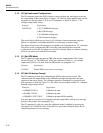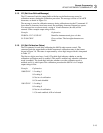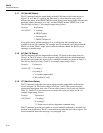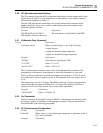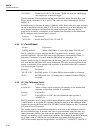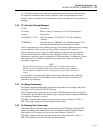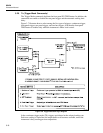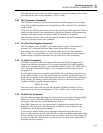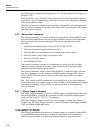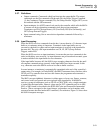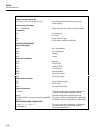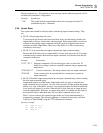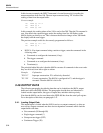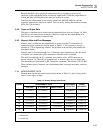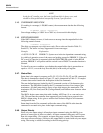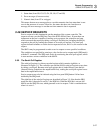
8842A
Instruction Manual
3-20
Error messages are indicated by an exponent of +21. For more about error messages, see
paragraph 3-40.
Since the 8842A is reset at the end of the self-tests, the Z0 command should be the last
command in a given command string. The 8842A will ignore any subsequent commands
in the same command string.
When the self-tests are complete and no errors have occurred, the serial poll register will
have bit 5 (Data Available) true and bit 6 (Any Error) false. See paragraph 3-50 for more
about the serial poll register.
3-34. (Device-Clear Command)
The asterisk command (*) is a device-dependent message which resets the 8842A to the
power-up default settings and clears all registers and buffers except for the input buffer.
The remote/local status remains unchanged. The asterisk command performs the
following:
1. Implements the default settings F1, R0, S0, T0, D0, B0, Y0, W0.
2. Clears the error status register (equivalent to X0).
3. Zeros the SRQ mask, prohibiting service requests (equivalent to N0 P1).
4. Zeros the numeric entry register (equivalent to N0).
5. Zeros the serial poll register.
6. Sets the SRQ line false.
The asterisk command is executed in its proper turn in a string, just like any other
command, without affecting the contents of the input buffer. All commands which
precede the asterisk command are performed.
The asterisk command is useful to ensure that the 8842A is initialized to the same state
each time a program is run. By contrast, the similar interface messages DCL (Device
Clear) and SDC (Selected Device Clear) cause the entire input buffer to be cleared
immediately.
DCL, SDC, and the asterisk command are all considered to be device-clear commands
because the results are so similar; however, DCL and SDC are not identical to the asterisk
command described here. DCL and SDC are discussed further in the paragraph on
interface messages.
3-35. ? (Single-Trigger Command)
The Single-Trigger command (?) causes the 8842A to take a reading and place the result
into the output buffer. To accept this command, the 8842A must be in external trigger
mode (selected by the T1, T2, T3, or T4 command).
The Single-Trigger command is one of five ways to trigger a reading. (See Figure 3-7.)
Of these, only the Single-Trigger command (?) and the Group Execute Trigger command
(GET) are loaded into the input buffer.
3-36. INPUT SYNTAX
The following paragraphs describe how to construct groups of commands for the 8842A.
A few definitions are presented first, followed by a description of how the 8842A
processes input commands. Guidelines are then summarized in four syntax rules.



